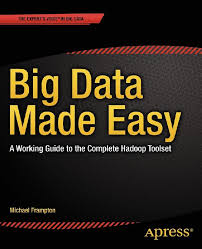White Paper: Harnessing the Power of Big Data: A Practical Guide
Abstract
Big data has revolutionized industries across the globe, enabling organizations to extract valuable insights from massive datasets. "Big Data Made Easy" by Apress provides a comprehensive introduction to the world of big data, covering essential concepts, technologies, and practical applications. This white paper delves deeper into the key themes of the book, exploring how organizations can effectively leverage big data to gain a competitive advantage.
Introduction
The exponential growth of data has created both challenges and opportunities for organizations. Big data technologies offer the tools and techniques to harness this data and unlock its potential. This white paper aims to demystify big data and provide practical guidance for organizations looking to embark on their big data journey.
Key Concepts of Big Data
- The 5 Vs of Big Data:
- Volume: The sheer amount of data generated.
- Velocity: The speed at which data is generated and processed.
- Variety: The diverse formats and sources of data.
- Veracity: The quality and reliability of data.
- Value: The potential value that can be extracted from data.
- Big Data Technologies:
- Hadoop: A framework for distributed storage and processing of large datasets.
- Spark: A fast and general-purpose cluster computing system.
- NoSQL Databases: Databases designed to handle large volumes of unstructured data.
- Data Warehousing: A centralized repository for storing and managing data.
- Data Mining and Machine Learning: Techniques for extracting insights and making predictions from data.
Real-World Applications of Big Data
- Retail: Personalized recommendations, customer segmentation, and fraud detection.
- Healthcare: Predictive analytics for disease prevention, drug discovery, and personalized medicine.
- Financial Services: Risk assessment, fraud prevention, and algorithmic trading.
- Telecommunications: Network optimization, customer churn prediction, and targeted marketing.
- Government: Public safety, urban planning, and policymaking.
Building a Big Data Infrastructure
- Data Ingestion: Collect and ingest data from various sources, including databases, APIs, and IoT devices.
- Data Storage: Store data in a scalable and reliable data storage system, such as Hadoop Distributed File System (HDFS) or cloud-based storage solutions.
- Data Processing: Process and analyze data using tools like Apache Spark, Hadoop MapReduce, and Apache Flink.
- Data Analysis: Apply data mining and machine learning techniques to extract insights.
- Data Visualization: Visualize data to communicate findings effectively.
Challenges and Best Practices
- Data Quality: Ensure data accuracy, completeness, and consistency.
- Data Security and Privacy: Protect sensitive data from unauthorized access and breaches.
- Scalability: Design systems that can handle increasing data volumes and complexity.
- Talent and Skills: Develop a skilled workforce to manage big data initiatives.
- Ethical Considerations: Address ethical implications, such as bias and privacy.
Conclusion
Big data has the potential to transform industries and drive innovation. By understanding the fundamental concepts, technologies, and best practices, organizations can harness the power of big data to gain a competitive edge. By leveraging the insights from "Big Data Made Easy" and other resources, you can embark on a successful big data journey and unlock the value hidden within your data.
References
- Apress. (2016). Big Data Made Easy. Apress.
- Hadoop: The Definitive Guide by Tom White
- Learning Spark: Lightning-Fast Big Data Analysis by Holden Karau, Andy Konwinski, Patrick Wendell, and Matei Zaharia
By combining theoretical knowledge with practical experience, you can effectively leverage big data to solve complex problems and drive business growth.



